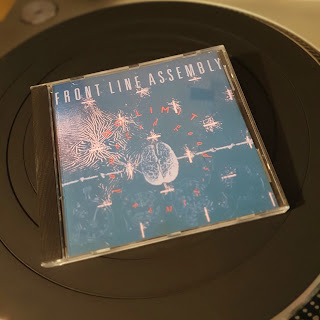You will be unsurprised to hear that when I was at school, music was a frequent topic of conversation. My school days coincided with the peak of the Eurythmics commercial success and albums such as "Be Yourself Tonight", "Touch" and "Savage" would occasionally feature in our conversations.
However, there was always one Eurythmics album that was regarded with suspicion and doubt. "In The Garden" predated the bands success and nobody dared risk their precious pocket money on such an unknown quantity.
However, as I had a reputation for being a voracious consumer of music, there was an assumption by some that I owned the album. One day I was asked directly if I had heard the album and what I thought of it. The question was posed in a way that suggested reverence to my opinion. Full of adolescent self importance I lied and said, "Yeah, I have it and it's quite good."
Some weeks later the same kid came back to me and said they had splurged their pocket money on a copy of "In The Garden" and either I had lied or my taste was poor. I remained diplomatically silent on the issue, but did feel guilty enough to purchase the CD in a strange effort to wallow in the same misery. Unfortunately I no longer own that original CD, but I did pick up the vinyl from eBay six or seven years ago and I will be playing that for this review. The dynamics on the vinyl are a little flat but this probably reflects
the mastering style of the time rather than incompetence. Happily my
copy doesn't seem to have any scratches and is in very good condition
through out.
Before we start it is worth noting that this album was recorded before Dave and Annie adopted synthesizers and achieved commercial success. The music on this record is in a more typical rock style and it is no wonder it failed to satisfy teenagers looking for another "Sweet Dreams (are made of this)".
Whilst the songs here might lack immediate appeal, they do still hold some interest. Things don't get off to an auspicious start as "English Summer" is a little languid and Annie's vocals lack confidence. But if you persist the chorus does deliver some charm before the songs peters out. Things kick up a gear or two with "Belinda" with its chugging guitar riffs and robotic drumming. There's no doubt this is a catchy tune that would have been great if it was recorded using synths rather than by a conventional rock band (even if Robert Görl is playing drums).

"Take Me to Your Heart" benefits from a synth driven backbone that is only slightly undermined by the uninspired bass guitar. Here Annie seems to be finding her voice and sings as if she believes in the material rather than just churning out album filler. The song is a little one dimensional but you can definitely hear the hints of what was to come in later albums. "She's Invisible Now" harks back to the sixties with some nice synth arpeggios thrown in, but Annie's vocal has reverted back to brittle sounding whispers. Side one closes with "Your Time Will Come" which builds into quite a good song, but like many here, it's little raw and under developed.
On the flip side "Caveman Head" does have a nice little synth riff running throughout, but it is essentially the same groove running without variation for four minutes. The highlight of the album for me is "Never Gonna Cry Again" which was also released as a single. I first heard this song on the post-split 'cash in' album "Live 1983-1989" in which Annie lets rip with a fantastic flute solo that is sadly missing on the album version. The next track "All the Young People (of Today)" comes and goes without making much impression but the French vocals and natty melody of "Sing-Sing" are very accomplished. We finish off with the middling "Revenge" which would later be re-recorded more successfully as "Revenge 2" for the album of the same name in 1986. 3/5








